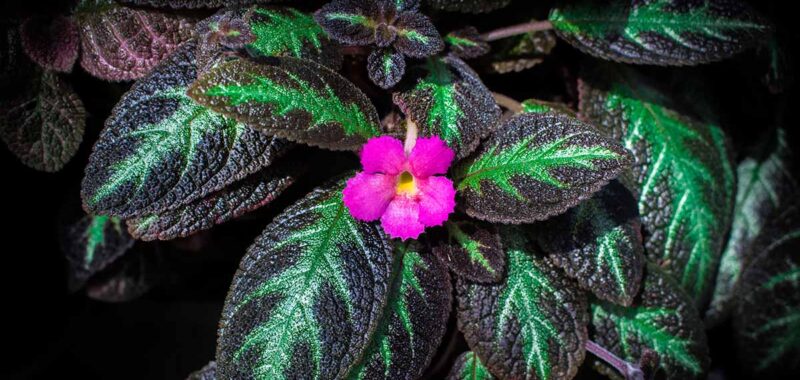Pink Panther
Colorful as Inspector Clouseau, the velvety leaves of ‘Pink Panther’ have hearts of kiwi to lime green with wide borders in burgundy, chocolate, or deep pink, and a frosty silver finish.
Pink or red flowers add to the vibrant display, adding charm to hanging baskets, planters, shelves, and terrariums.
Pink Smoke
Add a little atmosphere to your interior spaces with the dusty tones of ‘Pink Smoke.’ This cultivar features smoky, dark green to mahogany leaves, neon pink edges, and kiwi green veins.


‘Pink Smoke’
Prolific stolons with small plantlets grow at regular intervals and hot pink flowers finish off the smoldering look.
Starter plants in two-inch pots are available at Walmart.
Silver Screen
Always ready for a closeup, the downy leaves of ‘Silver Screen’ are celery green to silver, bordered in mahogany or forest green, and finished in a slight copper or red tint.


‘Silver Screen’
Bright pink or red flowers give a final colorful touch to this cultivar that shimmers with a metallic sheen.
Four-packs of starter plants can be found at Walmart.
Maintenance
Flame violets are low maintenance, but these fast growers benefit from regular grooming to keep them tidy and to prevent a crowded, overgrown appearance.


Use clean, sharp scissors to trim away dead or damaged leaves as they occur. And cutting back spent blooms as they fade and dry encourages more flowers.
For any kind of delicate work like grooming houseplants or propagation, I like to use pruning snips that give good dexterity and have sharp blades.
I particularly like these Fiskars Softouch Micro-Tip Pruning Snips.


Fiskars Softouch Micro-Tip Pruning Snips
You can find them available via Amazon.
To prevent them sprawling, snip off stolons as desired and use the trimmed baby rosettes to start new plants.
Repotting
Flame violets also appreciate repotting every couple of years to refresh the soil and give the roots more room.
The best time to repot is in late winter or early spring – provide plants with a new container that’s two to four inches larger than its current home.
Propagation
Although flame violets can be propagated from seed, if you want a clone of the parent plant, it’s best to use leaf cuttings or stolons, which produce reliable and fast results.


Propagation via stolons is basically the same as propagating stem cuttings.
- In spring or summer, select stolons with healthy plantlets at the stem tips that have at least four leaves.
- Use clean, sharp snips to cut off plantlets with two or three inches of the stolon stem attached, then dip the stem in rooting hormone if desired.
- Prepare small pots with moistened potting soil and carefully push the cut end into the medium, firming it gently around the stem.
- Set the pots in a location with bright, indirect light and maintain lightly moist soil.
- Rooting should happen in three to four weeks.
Leaf cuttings is another easy propagation method that produces reliable results.
Just follow the step by step instructions in our guide to propagating African violets from leaf cuttings.
Managing Pests and Disease
If you give your flame violets the conditions they thrive in, problems with pests and disease will be few and far between.
But it’s always wise to be on the lookout for any issues that may crop up.
Aphids or mealybugs are the main pests that might feed on your plants.

